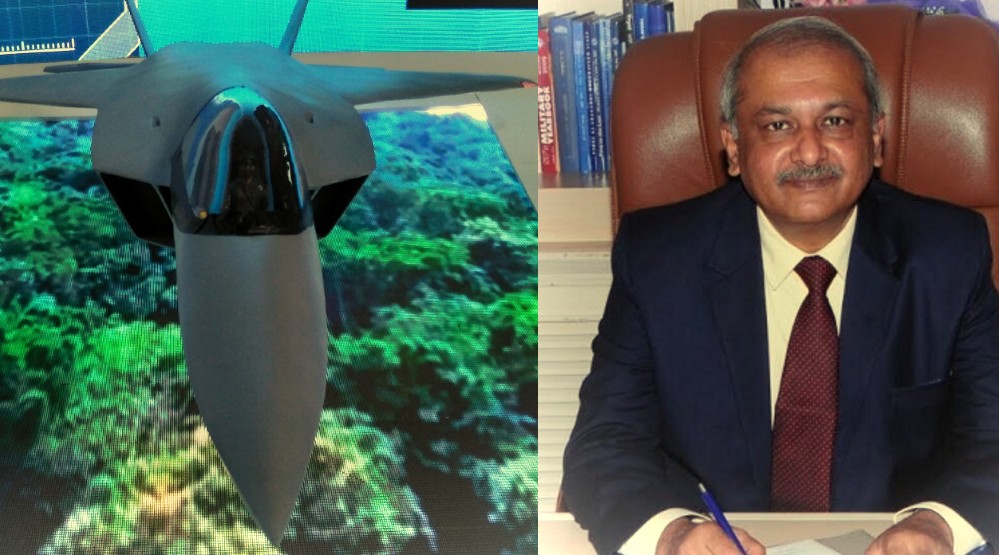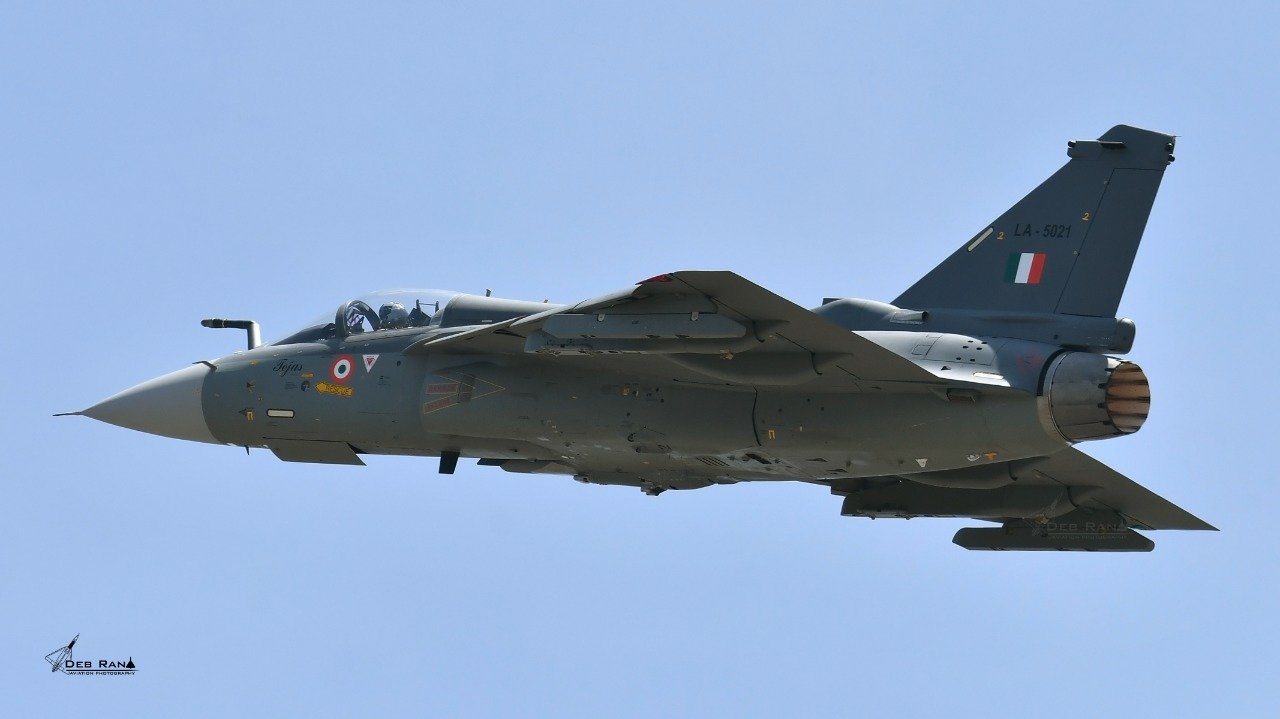
India’s fifth generation fighter program, the Advanced Medium Combat Aircraft (AMCA) will be a corporate public-private program, a massive break from the traditional ‘goverment-only’ shape of all military aviation projects thus far. Livefist can confirm that India’s HAL and the Aeronautical Development Agency (ADA) are in the process of laying the contours for a joint venture company to execute the AMCA program. The joint venture company will be a three-way partnership between HAL, DRDO (via ADA) and an Indian private sector firm.
Speaking to Livefist’s Shiv Aroor as part of an exclusive interview, HAL chairman and managing director R. Madhavan said, “HAL and ADA are together in the design of AMCA. We are also looking at productionisation already — we want to create a special vehicle, a joint venture company between HAL, DRDO and a private partner.”
It is not yet clear how the private partner in the AMCA project will be chosen, though it is clear that HAL and DRDO are keen to progress the proposed structure and create a special purpose vehicle (SPV) as quickly as possible. The decision to include a private partner as an equal stakeholder in a joint venture is groundbreaking in Indian aerospace projects, with private firms so far confined to being tier-level suppliers of systems and subsystems. If the proposal goes through, it will be the first time a private firm will be on equal financial and work terms with HAL and DRDO on a military armament project.
Adding detail to timelines on the AMCA, Madhavan said, “It’s on the drawing board. Preliminary design is completed. First prototype will be out (flying) by 2026-27. Secondly, as far as 4th Generation and 5th generation fighters, the latter loses out in terms of aerodynamics owing to stealth requirements, so not a good idea to put everything in one aircraft. With LCA Mk.2 and AMCA, we will be having both varieties — 4+ generation and 5th generation. One doesn’t replace the other. If you look at the US, they too are buying fourth generation jets in addition to the F-35.”
India pulled out of the Su-57 fifth generation fighter program with Russia in 2018 after a committee warned that the IAF and HAL were headed the ‘Su-30’ way with the crucial FGFA, and would likely end up as bankrollers to the program in the short term, and nothing more than license-builders in the long term. A concerted view was taken with the IAF to walk away from the Indo-Russian project, despite moneys already sunk.

In related remarks that make for the most ambitious promise in Indian military aviation, Madhavan also said that the first prototypes of three separate new Indian fighter concepts, including the AMCA, will be rolled out in four years. He said that HAL and its partner, the Aeronautical Development Agency (ADA) are working to unveil prototypes of the Light Combat Aircraft Mk.2, a new twin-engine LCA derived deck based fighter and the AMCA, in the next 3-4 years.
Answering a question on the twin-engine deck based fighter that HAL & DRDO have embarked on with government clearance earlier this month, Madhavan said, “So first the LCA Mk.2 will come out, and then the TEDBF and then AMCA. Prototypes of all three within 3-4 years. So 7-8 years is what we’re looking at for each of these aircraft getting airborne, which is a very short time in terms of aeronautical design.”
Part II of Livefist’s interview with the HAL chairman is now up on our YouTube channel:


Stuff & Nonsense from HAL. Even the additional requirements of Su30MKI of Super Sukhoi standard will be imported from Russia to touch req. figure of 18 squadrons or 324 aircraft HMRCA. OTOH, the LCA Mk1 (40), Mk1A (83) & the Mk2/MWF (201) will be made in India for another 18 squadrons or 324 LMRCA. The only other MMRCA possible, if it succeeds can be the AMCA 5/6 Gen but it’s at least 20 years away. The 114 Fighter Aircraft will be just the Rafale MMRCA IMPORTED in successive tranches of 36-40 aircraft. It’s not feasible to manufacture 4thGen aircraft under license. SU30MKI cost 2.5times more to make under license. Make LCA/MWF now & maybe in future 5/6 Gen AMCA at least 20 years later. TEDBF is too late, but best of luck on that The Rafale is what the IAF needs & wants for it’s MMRCA role.
TEDBF is not late at all. If you see all the navies around the world, F 35 is the only carrier borne naval aircraft that can be called better than TEDBF at this point (you can also argue bout F 18 as well though, but it will be in the same league as TEDBF). And US is going to be an ally at least for the next decade or 2 (and consequently, so will be it’s allies). Even China is not able to develop a decent carrier borne aircraft, and you can’t expect their first attempt to be much better than TEDBF. So even they are not gonna do much better any time soon. So overall, seeing the threat perception and security scenario, TEDBF will be more than enough.
HAL always promises much but when asked to deliver on time they always have an excuse they are nothing but the example of government run factories dishing out garbage .Look at what position IAF has been brought to by the bureaucracy still flying
The coffins named mig 21 .. they have no shame
HAL developed new product much much faster than any other country in the world.
Every country in the world took more than four decades to come up with a product at first time when they invented.
Of course, they developed in steps, and for each step they got order.
But in India, HAL did not received orders for each step, but instead asked to improve, improve and improve without orders which created too much of artificial financial constraints that limited its resource mobilization but still completed in lesser time than any other country.
It is completely a different matter, that , Indian media is very very good in criticizing the one who do the actual work.
It is a common mindset originated in Indian villages.
There exist a section in most of the villages, who wont do any useful work but criticize others who actually do the work.
These section people are busy now in Indian media and do criticize HAL.
Corporate politics also funded them and given more advertisement so that it will be easy for them to sell their products.
All are part of the Big Game.
he he
Why you ppl were so late.. Waiting for china to attack or anyother country to take initiative….this is my question
Finally a private player in sight is a good initiative. it would bring some agile production of new aircraft. ADA/HAL should still be focusing on more on research in partnership with our premier institutes.
It feels like an insult to Indian talent, to go purchase military hardware outside on occasions, in order to feel safe, in situation like now.
I believe we have good defence manufacturing sector setup now. What we need is cut on bureaucratic decision making. I like the approach Mr Mahohar Parikar used to take, i could litterally feel his turnaround strategy on LCA…. Sad he is no more with us…
Sir I am a defense enthusiast and a regular follower of your blog I myself have a blog named intelpage99.blogspot.com
We were late, because, of sanctions imposed by Developed countries (US, Russia, China, France, UK) and because of too many agreements signed among them to restrict other countries from developing technologies.
When they observe any single intelligent person, who have the capability to quickly produce technology then they used to kill them or suppress them with their influence.
It is not easy doing then saying and commenting.
A waste of time and money reinventing a 4th-gen fighter.We already have the MIG-29/35 or Rafales if we need more of them. We also have no money for the navy’s wet dream,the 3rd. carrier,which with its escorts,fleet tanker,and full complement of fighters and multi-role copters will cost some $15-$20 B. So the TEDBF,yet another 4th-gen fighter that too with a limited production line of less than 60 fighters would be prohibitively expensive to design,develop and produce at HAL’s snail’s pace prod. rate.
The common-sense approach is to design a 5th-gen stealth fighter,the AMCA along with a naval variant that will enter production around 2030 and build as many LCAs,MK-1/1A/1B,etc., as we can improving variants until the AMCA starts arriving to replace MIG-29s,Mirage-2000s and Jaguars.
For this decade,the SU-57 bought in enough numbers ,2 to 3 sqds.,will be adequate to match any PLAAF and PAF deployment of J-20s. The money saved on canning the TEDBF and LCA MK-2 twin-engined fighter could be used to buy more Rafales or Fulcrums. The biggest joke of all is that we do not have yet a single indigenous fighter engine,the key to all the fighter programmes, other than the ancient Kaveri of which not a single unit has been fitted to any fighter!
These ultra-ambitious fighter programmes given the same mentality of management will ultimately end up like the IJT (now being given a last chance) fit to be interred in the cemetry.
As far as the JSF/F-35 is concerned,it is so intensively software driven that innumerable problems have been experienced with the limited number of aircraft delivered. Its logistic diagnostic system ALIS is so trouble-prone that a new system called ODIN is on the cards also being met with scepticism.It has a 25mm gun that can’t shoot straight at ground targets in a housing that’s cracking up thanks to vibration. One of the problems with composites,same for the LCA, is that you have to fix locations for your mountings for internal equipment before the composite panels are made,taking into account loading stresses,etc.One cannot later on simply alter the location as done with metal fuselages,etc. This may be why the LCA’s gun has yet to appear as an integral feature.
This most expensive fighter programme in history being so problematic, is to be replaced with yet another fighter the contours of which are in the pipeline.This is the reason why extra F-18s are being acquired as an interim measure with fingers crossed for the F-35s problems to be resolved with time and the arrival in the future of a new replacement fighter. At around $100M a unit,with a most complex maintenance infrastructure required to support the baby, availability times will not be as high as non-stealthy fighters too,making it far less cost-effective than buying conventional fighters,especially when a major role is close support (replacing the A-10) and strike.In the age of long-range PGMs and ASMs, even a non-stealthy fighter can do the business equipped with the same ordnance. Moreover,the F-35 is no better than an F-16 in air combat,never intended to be an air-superiority bird as it was thought during conception that stealth would be a magic bullet. The F-16 with one of the hottest backsides in the avian world,is dead meat for IR missiles and IRST sensors in detecting it too.
In the era of increasing use of stealthy UCAVs,even by militant fighters like the Houthis in S.Arabia,
UCAVs are fast becoming the weapon of choice for strike missions,especially when one does not want to send pilots into “harm’s way”. If the F-35 cannot overcome its many problems,and soon, it will end up being the most expensive turkey in fighter aviation history.
AMCA program partners DRDO-ADA and private firm’s consortium will be right partners nota single “pvt firm”. Consortium partners should team up with GTRE and foreign firm GE/Rolls Royce to make next gen engines suitable for stealth fighter !